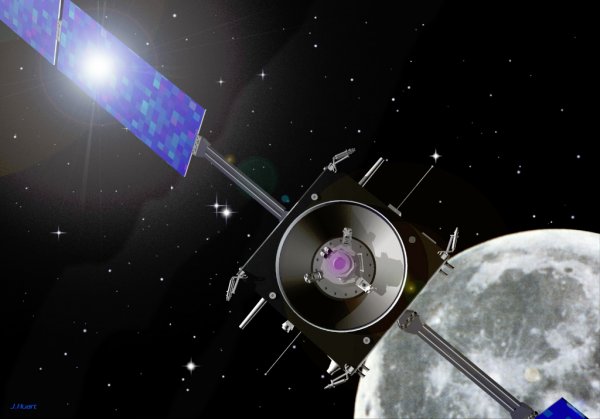| SPACE TODAY ONLINE COVERING SPACE FROM EARTH TO THE EDGE OF THE UNIVERSE | ||||||||||
| COVER | SOLAR SYSTEM | DEEP SPACE | SHUTTLES | STATIONS | ASTRONAUTS | SATELLITES | ROCKETS | HISTORY | GLOBAL LINKS | SEARCH |
Europe's innovative Moon probe SMART-1...
Mapping the Entire Lunar Surface
SMART-1 SENDS POSTCARDS HOME
The Small Missions for Advanced Research in Technology (SMART-1) spacecraft is conducting Europe's first exploration of the Moon.
ESA artist's view of Europe's SMART-1
click to enlarge
First pictures. SMART-1 sent back to Earth its first close-up images of the Moon's cratered landscape recorded between December 29, 2004, and January 3, 2005.
The SMART-1 images will be used over time to construct a map of the entire lunar surface.
The current images are medium resolution. Higher-resolution images recorded when SMART-1 flies at a lower altitude will be integrated into the map later.
Sailing to the Moon. An Ariane 5 rocket ferried the unmanned, solar-powered, SMART-1 lunar exploration probe to space on September 27, 2003, from the European Space Agency's Guiana Space Center at Kourou, French Guiana, on the northeast coast of South America.
SMART-1 was released from the rocket into Earth orbit 41 minutes after launch. From there it began a 14-month journey into orbit around the Moon. It made the trip with a relatively-weak ion thruster engine powered by energy absorbed from the Sun. Such a powerplant is able to thrust for a longer period of time than the chemical thrusters aboard other spacecraft.
The probe entered lunar orbit on November 15, 2004. After that, it spiraled ever closer to the Moon and tested its instruments.
Electric propulsion. SMART-1 used the latest solar electric ion propulsion technology to move from Earth orbit to its elliptical orbit around the Moon. The propulsion system is slow. It required 18-months for the journey to the Moon, but it's lightweight and inexpensive to operate.
SMART-1 first photo of the Moon
click to enlarge
The probe's solar panels convert sunlight into electricity, which is used to convert xenon gas atoms into ions. The ions stream out of the aft end of the engine pushing the spacecraft forward.
Later, European engineers plan to use similar solar-power ion engines for longer spacecraft trips to Mercury and Mars — including Europe's BepiColombo mission to Mercury. Ion thrusters were used previously on NASA's Deep Space 1 mission to a comet in 1998.
The 815-lb. SMART-1 spacecraft is about the size of a home clothes washing machine.
SMART science. The probe is expected to work in lunar orbit for at least two years as a testbed for new propulsion, astronomy and communication technologies.
SMART-1 uses a high-resolution camera, an infrared spectrometer, and a battery of miniature instruments to:
- conduct detailed mapping of the Moon's surface, including the far side never seen from Earth.
- examine infrared light as it looks for water hidden deep in craters on the lunar surface.
- use X-rays to map the chemical composition of the lunar surface. A spectrometer will measure the amounts of key elements such as silicon, aluminum and magnesium in rocks on the lunar surface.
- gather chemical data to test a theory that the Moon was created when a giant asteroid struck Earth during the early days of our Solar System 4.5 billion years ago. That theory would be supported by a greater presence of lighter elements such as magnesium or aluminium vs. a lesser presence of heavy elements such as iron.
- test the establishment of a laser beam link with Earth for communications.
details > SMART-1 [ESA]
details > SMART-1 [ESA]
details > SMART-1 [STO]
More information on Europe's science spacecraft
Including 3D models and views from orbit, from Earth and from the Solar System
| Europe in Space | | | Search STO | | | STO cover | | | Questions | | | Feedback | | | © 2005 Space Today Online |

